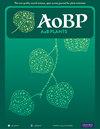垂藓的伸缩荚膜、吸湿运动及孢子释放模型
IF 2.6
3区 生物学
Q2 ECOLOGY
引用次数: 0
摘要
苔藓吸湿运动在保护和控制孢子释放中起着重要作用。近年来对壁壁吸湿运动和孢子释放的研究主要集中在具有“完美”壁壁的苔藓类,如Brachytheciaceae,而对“特殊”壁壁的吸湿运动类型和孢子释放模式,如Regmatodon declinatus,了解甚少。通过吸湿性运动参数的测定和吸湿性运动孢子释放试验,探讨了“专门化”垂叶枯壁吸湿性运动与孢子释放的关系。结果表明:①外生口明显短于内生口,引发了伸缩的外生口吸湿运动,外生口在靠近内生口时迅速伸长,牙齿迅速收敛。②单独触发活壁运动时孢子释放最小。暴露在风中的孢子数量是无风条件下的124倍。干胶囊释放的孢子比湿胶囊多7倍。研究表明,“伸缩”型枯壁吸湿运动对孢子释放的贡献不显著。当风和吸湿运动协同作用时,释放出更多的孢子。干燥的蒴果释放出最多数量的孢子。研究还发现,蒴果的结构损伤可以促进孢子完全释放。最后,建立了斜叶霉孢子从萌发到完全释放的过程模型,即风-水囊结构损伤耦合释放模型。本文章由计算机程序翻译,如有差异,请以英文原文为准。
Telescopic peristomes, hygroscopic movement, and the spore release model of Regmatodon declinatus (Leskeaceae Bryophyta)
Abstract Moss peristome hygroscopic movement plays an important role in protecting and controlling spore release. Recent studies on the peristome's hygroscopic movement and spore release have focused on mosses with "perfect" peristomes, such as Brachytheciaceae, whereas the hygroscopic movement type and spore release pattern of "specialized" peristomes, such as Regmatodon declinatus, are poorly understood. We investigated the relationship between the peristome's hygroscopic movement and spore release in the "specialized" peristome of R. declinatus by the measurement of peristome hygroscopic movement parameters and the hygroscopic movement spore release test. It was found that: ①Exostomes (EX) are significantly shorter than endostomes (EN), triggering the hygroscopic movement of telescopic peristomes, in which the EX rapidly elongate while closing in on the EN, and the teeth rapidly converge. ② Spore release was minimal when peristome movement was triggered alone. The number of spores released when exposed to wind was 124 times greater than in the absence of wind. Dry capsules released seven times more spores than wet capsules. The study reveals that the hygroscopic movement of "telescopic" peristomes of R. declinatus did not contribute significantly to spore release. More spores were released when wind and hygroscopic movement acted synergistically. Dry capsules released the maximum number of spores. It was also revealed that structural damage to capsules can facilitate complete spore release. Finally, we modeled the release of R. declinatus spores from initiation to complete release, namely the coupled release model of wind-water-capsule structural damage.
求助全文
通过发布文献求助,成功后即可免费获取论文全文。
去求助
来源期刊

AoB Plants
PLANT SCIENCES-
CiteScore
4.80
自引率
0.00%
发文量
54
审稿时长
20 weeks
期刊介绍:
AoB PLANTS is an open-access, online journal that has been publishing peer-reviewed articles since 2010, with an emphasis on all aspects of environmental and evolutionary plant biology. Published by Oxford University Press, this journal is dedicated to rapid publication of research articles, reviews, commentaries and short communications. The taxonomic scope of the journal spans the full gamut of vascular and non-vascular plants, as well as other taxa that impact these organisms. AoB PLANTS provides a fast-track pathway for publishing high-quality research in an open-access environment, where papers are available online to anyone, anywhere free of charge.
 求助内容:
求助内容: 应助结果提醒方式:
应助结果提醒方式:


